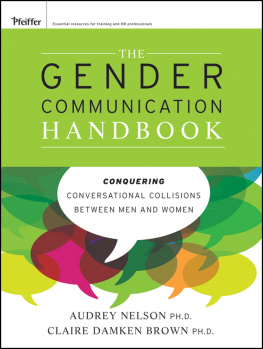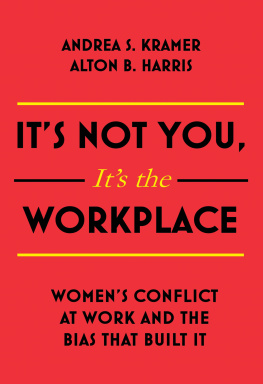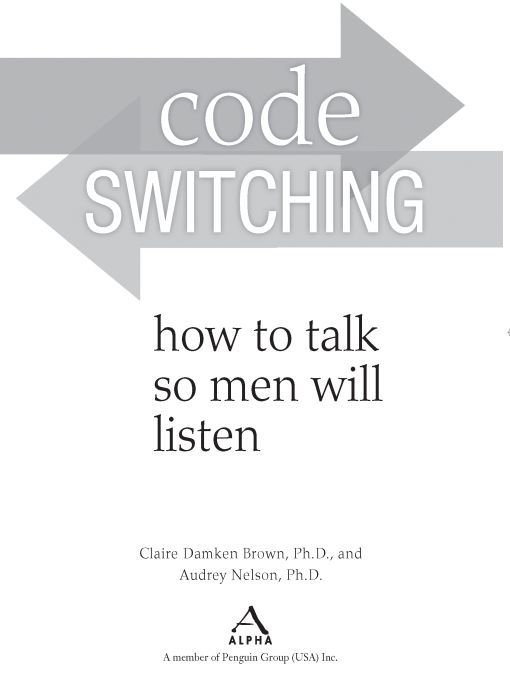Table of Contents
To my husband, Larry; sis, Mary; and nieces and future business leaders:
Allison, Maggie, Samantha, Brittany, Stacey, Shanna, and Sadie (who is
one day old as of this writing)
Claire
To Geoffrey Wade Simpson
Audrey
Introduction
My female coworker keeps saying I never listen to her or something like that.
Thats our twist on an old clich. And sometimes it feels truefor both men and women in the workplace.
Did he hear me? Is he ignoring me? What do I need to do to get someone to notice me around here? Why doesnt he take me seriously?
Chances are, these questions or some variation thereof have run through your mind while youve been waiting to talk to a man at work.
Weve heard it over and over, the same story across the nation. A woman throws an idea on the table, and no one reacts. She may as well have just cleared her throat. Ten minutes later, Bob offers the same idea and the room perks up; thats the best idea since the underwire bra.
To the womans amazement (read: horror), the supervisor and coworkers began discussing the idea. So innovative! This new approach could save time and money. They commend Bob on his creativity, while she sits next to him in a haze, jaw dropped, thinking, This is so surreal. I just said that.
Should she demand credit or let it go? What is she supposed to do now?
Well, for starters, read on. The authors of this book have 60 years of combined work experience with businesswomen who feel ignored, not part of the game, isolated, or unable to make an impact at work. Using their expertise in gender communication, office politics, and organizational rules of engagement, Audrey and Claire teach women how to prepare for these situations, take charge, and communicate effectivelyhow to go for it. Short of carrying around a bullhorn with you at work, their advice starts with understanding the gender differences and then using that knowledge to code-switch.
Code Switching: How to Talk So Men Will Listen is a hands-on tool for everyday use at the office. It is a practical resource with how-to steps to help businesswomen conquer the communication nuances between men and women in the workplace. This book explores the gender impact on business talk. It teaches using true stories and case studies, while providing valuable code switching tips to help women gain and strengthen credibility, and make a greater impact on the job.
This is not a male-bashing book! (For that, see our male-bashing underground best-seller Now Hear This! Get Your Own Damn Coffee!) This is not about whether women are better than men or men are better than women. Were just differentgenetically and socially.
Were also not saying that women have to act like men. That is a formula for failure because its impossible, and it alienates everyone at the office. Plus, when you try that, you give up your femininity, and were the first to admit that its wonderful to be a woman. The workplace thrives with a balance between both the feminine and the masculine.
Bits and pieces of mens and womens communication styles benefit the workplace, make employees want to be there, and impact the bottom line. By gaining insight into mens and womens communication styles, we create an awareness of our communication choices. Its about consciously mixing it up using both the male and female communication styles to produce an overall androgynous, synergistic approach. This blend makes things happen. With knowledge of both styles of communication, you can intentionally switch between the two, based on your goal.
Weve adopted the term code switching, used in the study of linguistics. It refers to having knowledge of two cultures or languages and readily swapping between them as you communicate.
code SWITCHThe ability to use your knowledge of two or more cultures or languages and switch between them, depending on the situation, to best communicate your message.
To code-switch, you must have the flexibility and plasticity to move in and out of numerous everyday encounters. You dont use the same communication style in all encounters; you adjust to meet specific needs as they arise.
Knowing how men and women communicate and being able to switch between the two styles is crucial in the workplacenot to mention at home and beyond the office. Trying to understand men and women has become a lifetime challenge for most of us. We might be able to get away with a shrug and a Vive la diffrence! in some more casual personal relationships, but not at work, where coordination and synergy have a serious ripple effect.
The number of women entering the workforce has gradually increased over the past three or four decades. In entering the male business domain, women often were viewed as misfits and had to modify their ways to suit the masculine work culture. Today nearly as many women are working as men. According to the U.S. Department of Labor, 46 percent of the workforce are women. Of those working women (a whopping 68 million), 75 percent work full-time and 25 percent work part-time. The Department of Labors statistics show that close to 60 percent of all U.S. women age 16 years and older have a job or are looking for one. For the first time, more women than men hold professional and managerial positions: 51 percent of the 48 million people in these positions are womendouble the percentage of two decades ago. More women than men are graduating from college, and with higher GPAs. Medical and law schools are approximately 50/50 in enrollment. Every day on the job, we interact with people of the opposite sex. Theres no getting around it.
We mean business! How do women unlock the door and get men to listen? Many businesses are concerned about inclusiveness. They conduct diversity training but ignore or dont emphasize educating their employees to be fluent in womens and mens communication styles. How many companies provide mentors for women employees that coach them on how to present ideas and make an impact on the men they work with (usually their bosses)?
Are men still the bosses? The October 2008 Catalyst Research Pyramid of women in U.S. companies indicates that women make up 2.4 percent of the Fortune 500 CEOs, and 6.7 percent of the top money makers and 15.4 percent of corporate officers in Fortune 500 companies. As much as things are changing, theyre not changing fast enough when it comes to moving women up the corporate ladder. If a woman is talking at work, theres a high probability that a man is on the receiving end and making a career-impacting decision for her based on what she just said.
Our Promise
Code Switching: How to Talk So Men Will Listen focuses on day-to-day communication at work. Our goal is to make women more aware of their communication strategies. The primary focus is on how women can get through to men. We provide advice on how you can use your newly acquired skills to enhance your career. Look for code switching tips in each chapter. These are simple, doable suggestions that you can implement right away.
For additional reading, see the Resources appendix for a list of books and articles mentioned in our chapters.
Everything in the officefrom problems to personal and companywide successes to satisfactionboils down to communication. Theres a direct link between our ability to communicate and our overall










